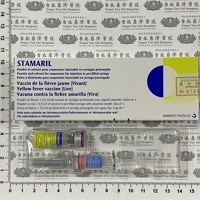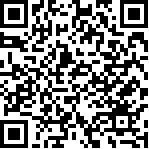藥品名稱
drug name | STAMARIL 0.5mL/vial (Yellow fever vaccine), 黃熱病注射疫苗 |
| 藥檔狀態 | 使用中 |
成 份
Ingredient | Yellow fever vaccine |
| 單位含量 | 0.5mL/vial |
| Dosage Forms | Injection, powder for reconstitution [17D-204 strain] [preservative free]: 0.5mL/vial |
| 外觀描述 | |
| Appearance | |
廠商名稱
Manufacturer | 賽諾菲股份有限公司 |
製 造 商
Manufacturer | Sanofi Pasteur Inc. |
字 號
Product ID | 專案進口,無衛署字號 |
藥理分類
Pharmacologic Category | Vaccine;Vaccine, Live (Viral) |
作用機轉
Mechanism of action | Yellow fever vaccine is a live vaccine that offers active immunization against yellow fever infection at an effective immune response rate of nearly 100% of patients. |
| 用途/適應症 | |
| Use |
Yellow fever prevention: Active immunization against yellow fever virus, primarily among persons traveling to or living in areas where yellow fever infection exists and laboratory workers who may be exposed to the virus; vaccination may also be required for some international travelers.
The Advisory Committee on Immunization Practices (ACIP) (CDC/ACIP [Staples 2010]) recommends vaccination for:
‧ Persons traveling to or living in areas at risk for yellow fever transmission
‧ Persons traveling to countries which require vaccination for international travel
‧ Laboratory personnel who may be exposed to the yellow fever virus or concentrated preparations of the vaccine
Although the vaccine is approved for use in children ≧9 months, the CDC recommends use in children as young as 6 months under unusual circumstances (eg, travel to an area where exposure is unavoidable) (CDC/ACIP [Staples 2010]).
|
衛福部核准適用症狀
MOHW approved indications |
預防黃熱病。
|
| 常用劑量 |
(藥品劑量會因人或病情增減,請依照醫師指示服用。) |
| Dose |
【Adult】
[Yellow fever prevention]
Primary immunization: SubQ: One dose (0.5 mL) ≧10 days before travel.
Booster: Based on currently available data, the World Health Organization (WHO) and CDC/ACIP have determined that vaccine failure is rare and booster doses are generally not needed. A single dose of the vaccine is adequate for most travelers. The World Health Assembly removed the 10-year booster dose requirement from the International Health Regulations in July 2016 (WHO 2016a). However, booster dose(s) are recommended for certain patient populations with conditions at the time of their initial dose that may limit immune response (eg, pregnant women, hematopoietic stem cell transplant recipients, HIV patients). A booster dose may also be given (≧10 years after last dose) to those who may be at increased risk for yellow fever disease (eg, certain laboratory workers [depending on antibody titers] and travelers to endemic locations for prolonged periods) (CDC/ACIP [Staples 2015]; WHO 2013).
Fractionated doses during community outbreak: Refer to WHO guidelines for information regarding fractional dosing as a vaccine dose-sparing initiative (WHO 2016b).
【Pediatric】
[Yellow fever prevention (immunization)]
Primary immunization (CDC/ACIP [Staples 2010]):
- Infants 6 months to <9 months: Limited data available: SubQ: 0.5 mL as a single dose ≧10 days before travel.
- Infants ≧9 months, Children, and Adolescents: SubQ: 0.5 mL as a single dose ≧10 days before travel.
Booster: Based on currently available data, the World Health Organization (WHO) and CDC/ACIP have determined that vaccine failure is rare and booster doses are generally not needed. A single dose of the vaccine is adequate for most travelers. The World Health Assembly removed the 10-year booster dose requirement from the International Health Regulations in July 2016 (WHO 2016). However, additional dose(s) are recommended for certain patient populations with conditions at the time of their initial dose that may limit immune response (pregnant women, hematopoietic stem cell transplant recipients, HIV patients). A booster dose may also be given (≧10 years after last dose) to those who may be at high risk for yellow fever disease (eg, certain laboratory workers [depending on antibody titers] and travelers to endemic locations for prolonged periods) (CDC/ACIP [Staples 2015]).
【Geriatric】
Refer to adult dosing. Monitor closely due to an increased incidence of serious adverse events in patients ≧60 years of age, particularly in patients receiving their first dose. The ACIP guidelines note that if travel is unavoidable, the decision to vaccinate travelers ≧60 years should be made after weighing the risks vs benefits (CDC/ACIP [Staples 2010]).
【Renal Impairment】
There are no dosage adjustments provided in the manufacturer`s labeling.
【Hepatic Impairment】
There are no dosage adjustments provided in the manufacturer`s labeling.
|
懷孕分級
Pregnancy Risk Factor |
依文獻內容判定系統稽核懷孕分級建置為:D
UpToDate:
[Reproductive]
Women should wait 4 weeks after receiving vaccine before conceiving (CDC/ACIP [Staples 2010]).
[Pregnancy]
Avoid use in pregnant women unless travel to high-risk areas is unavoidable. Pregnant women may not produce an adequate immune response to the vaccine, particularly in the third trimester (CDC/ACIP [Staples 2015]). Adverse events were not observed in the mother or fetus following vaccination during the third trimester of pregnancy in Nigerian women (n=101, including 89 in their third trimester); however, maternal seroconversion was reduced (39% seroconversion at 2 to 4 weeks after administration) (Nasidi 1993). Inadvertent exposure early in the first trimester of pregnancy (n=480, mean gestational age 5.7 ± 4.9 weeks) in Brazilian women did not show decreased maternal seroconversion (98.2% seropositive at ≧6 weeks after administration); no increased risk for major congenital abnormalities was observed (Suzano 2006). Cord blood from an infant whose mother was vaccinated during the first trimester tested positive for IgM antibodies (indicating congenital infection); no adverse events were noted in the infant (Tsai 1993).
Vaccine should be administered if travel to an endemic area is unavoidable and the infant should be monitored after birth. Tests to verify maternal immune response may be considered (CDC/ACIP [Staples 2010]). If a pregnant woman is to be vaccinated only to satisfy an international requirement (as opposed to decreasing risk of infection), efforts should be made to obtain a waiver letter.
Due to variable seroconversion during pregnancy, women who were initially vaccinated while pregnant may need a booster dose prior to traveling again to an area at risk for yellow fever virus infection (CDC/ACIP [Staples 2015].
-----------------------------------------------------------
[FDA(美國食品及藥物管理局)懷孕分級說明:
A:對照試驗無法證實懷孕初期及後期使用會危害胎兒。
B:動物試驗無法證實對胎兒有害,但缺乏人類對照試驗;或動物試驗有副作用報告,但無法證實對懷孕初期及後期之胎兒有害。
C:動物實驗中對胎兒有害但缺乏孕婦對照實驗;或無動物及孕婦試驗。
D:證實對胎兒有害,但疾病對孕婦有生命威脅或較安全藥品無法使用或無效時可使用。
X:證實對胎兒有害,且使用後危害大於可能的益處。孕婦及可能懷孕婦女禁用。]
|
| 禁忌症 |
1. Contraindicated in anyone with a history of acute hypersensitivity reaction to any component of the vaccine.
2. Contraindicated in infants less than 9 months of age due to an increased risk of encephalitis.
3. In lactating women who are providing breastmilk to infants less than 9 months of age due to the potential for transmission of vaccine virus in breastmilk.
4. Contraindicated in individuals with severe immunosuppression.
|
| Contraindications |
Acute hypersensitivity to egg or chick embryo protein, or any component of the formulation, including gelatin; infants <9 months (per manufacturer); infants <6 months (CDC/ACIP 2010 guidelines); severely immunosuppressed patients (eg HIV infection, leukemia, lymphoma, thymic disease, generalized malignancy, or immunosuppression due to drugs or radiation); lactating women providing breast-milk to infants <9 months.
|
| 常見副作用 | |
| Common adverse drug reactions | |
| Adverse Reactions |
>10%:
- Nervous system: Headache, malaise
- Neuromuscular & skeletal: Asthenia, myalgia
- Miscellaneous: Fever
1% to 10%: Dermatologic: Skin rash (3%)
Frequency not defined: Local: Erythema at injection site, localized edema (at injection site), pain at injection site
<1%, postmarketing, and/or case reports: Acute disseminated encephalomyelitis, anaphylaxis, cranial nerve palsy (bulbar), Guillain-Barre syndrome, hypersensitivity at injection site, hypersensitivity reaction, injection site blister formation, residual mass at injection site, urticaria, yellow fever vaccine-associated neurotropic disease (rare), yellow fever vaccine-associated viscerotropic disease (rare; may be associated with multi-organ failure)
|
★高警訊藥品
監測建議 |
|
監測
Monitoring |
Monitor for anaphylaxis and syncope for 15 minutes following administration. If seizure-like activity associated with syncope occurs, maintain patient in supine or Trendelenburg position to reestablish adequate cerebral perfusion. Monitor for adverse effects 10 days after vaccination (specifically in the elderly) (ACIP [Ezeanolue 2020]; CDC/ACIP [Staples 2010]).
|
| 警語與注意事項 | |
| Warnings & precautions | |
| 針劑溶解條件 |
請用所附之溶液泡製,施打前請充分振搖均勻。(1100331 仿單資料)
|
| 針劑稀釋條件 |
|
| 針劑不相容性 |
不可與其他藥品混合。(1100331 仿單資料)
|
| 針劑施打條件 |
皮下注射或肌肉注射,絕對不可以靜脈注射途徑給予;請務必確認針頭沒有穿透血管。(1100331 仿單資料)
|
| 針劑保存安定性 |
‧ 2-8℃冷藏,不可冷凍,避光。
‧ 任何未使用或廢棄的疫苗應丟棄,最好依據當地規範以加熱去活化或焚化的方式處理。(Any unused product or waste material should be disposed of, preferably by heat inactivation or incineration, in accordance with local requirements.)
(1100331 仿單資料)
|
最近修改日期時間
Updated | 3/31/2021 4:16:04 PM |
|

現用藥品
Available
|

停用藥品
Old item
|

藥品仿單
DrugLabeling
|
|

二維條碼
QR code
|
|